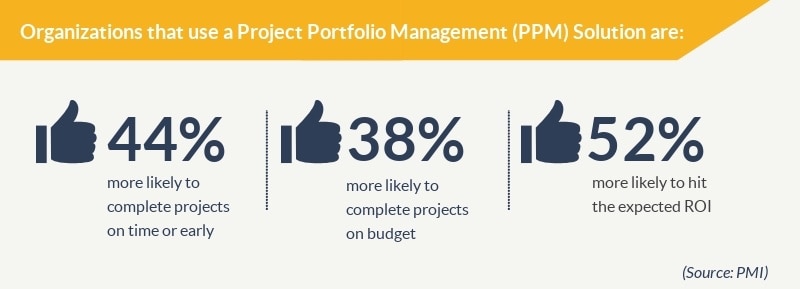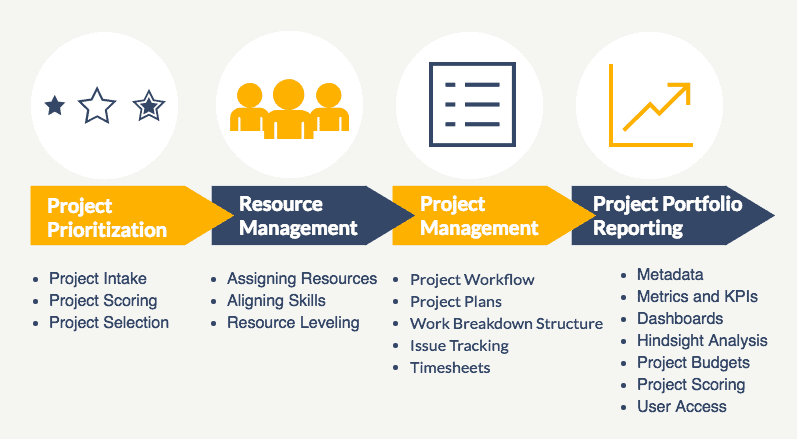Quick Take
You need Project Portfolio Management (PPM) software if you run projects because:
- Organizations using PPM tools are up to twice as likely to meet project objectives
- PPM Project Prioritization enables you to focus on projects that deliver the most value
- PPM enables you to better manage resources by effectively and efficiently performing tasks such as assigning resource availability, aligning skills to projects, and resource leveling
- PPM can provide an aggregate portfolio view and big picture analysis of all project plans as well as visibility into data at the project level
- PPM reporting gathers and analyzes project data over time and across the portfolio to support hindsight analysis that improves future project success
So, basically, if you run lots of projects, you need Project Portfolio Management software to help ensure success. If you’re not using PPM software, you are flying blind. We’ll expand on the concepts of PPM and give you tips to use to streamline success.
Increased Project Success
The Project Management Institute compared organizations not using PPM tools with organizations using PPM and found that tool users were:
- 44% more likely to complete projects on time or early
- 38% more likely to complete projects on budget
- 52% more likely to hit the expected ROI

We’re sure your organization would welcome improvements such as these.
Project Portfolio Management also enables you to use centralized management of portfolios to leverage successful project selection and execution to achieve strategic objectives. Thus, PPM bridges the gap between strategy and implementation commonly found in organizations.
What is Project Portfolio Management?
Let’s dig into what exactly Project Portfolio Management is.
PPM is the centralized management of the processes, methods, and technologies used by project managers and project management offices (PMOs) to analyze and collectively manage current or proposed projects based on numerous key characteristics.
Project Portfolio Management enables organizations to more effectively accomplish:
- Project Prioritization
- Resource Management
- Project Management
- Project Portfolio Reporting

We’ll take a look at these four facets in the following sections.
Project Prioritization
The first component of a Project Portfolio Management process is Project Prioritization. This process enables you to focus your organization on those projects that deliver the most value.
The process begins by identifying the projects that can best improve business goals by analyzing projects based on time, money, and resources. Your Project Prioritization framework should be data-driven, objective and scalable. It should also support the concepts of Governance and Transparency.
A first step in prioritizing projects is to identify the value of each project and how the project contributes to the organization’s mission. It is important to create a robust methodology to support different definitions of “value.” For some projects, value may be determined by increasing revenue. For others, value means reducing cost. A third measure of value could be a project that meets a qualitative goal such as “going green.”
A robust Project Prioritization process will also consider other facets when assessing the potential value a project might deliver. Your process should enable you to answer questions such as:
- Who submitted this project and what is its purpose?
- How do I compare these projects?
- Which strategic goal does this project support?
- Why was my project not approved?
- If I have limited resources, do I cancel any of my projects? Which projects?
- Do I hire additional resources for my project backlog?
Your Project Prioritization process should consist of the following steps:
- Project Intake
- Project Scoring
- Project Selection
Your PPM solution should contain a Project Prioritization template to capture or create data for each of step of the process.
Read our blog post on how to implement an effective Project Prioritization process here.
Resource Management
Resource Management is the process of efficiently and effectively using your organization’s budget, inventory, personnel and information technology (IT) assets.
Once initiatives have been selected and prioritized, the next step in your Project Portfolio Management process is to assign resources to projects.
PPM enables you to determine resource allocation using a top-down approach—either at the portfolio or organizational level. Using your PPM system, you can effectively perform tasks such as assigning resource availability, aligning skills to projects, and resource leveling.
Increased visibility into resource availability enables proactive management of resource schedules, which allows you to identify potential issues weeks or months in advance.
One of your most critical resources is likely to be workers. There are three important ways that Project Portfolio Management optimizes deployment of personnel:
- Resource Scheduling
- Skills Management
- Resource Leveling
Read our blog post on how to improve your Resource Management process here.
Project Management
It is essential that your PPM process provides an aggregate portfolio view of all project plans for big picture analysis. Project Portfolio Management software should also enable you to dive into data at the project level to analyze efficiency and resource allocation.
Project management must also be able to edit individual project plans and to visualize work breakdown structures for each initiative.
With these resources, your PPM software should enable project-level management to effectively handle problems, identify patterns, and do issue tracking to ensure timeliness of portfolio goals.
Effective Project Management workflow can classify and track projects, allowing you to answer questions like:
- How many initiatives have been requested for funding?
- How many projects are waiting for scoring?
- How many projects are active?
- Which projects have been archived?
A Project Management/Portfolio Management process must have the ability to review and alter the following processes:
- Project Workflows
- Project Plans
- Work Breakdown Structure
- Issue Tracking
- Timesheets
Read our blog post on how Project Portfolio Management (PPM) improves Project Management here.
Project Portfolio Reporting
An effective Project Portfolio Management process generates large volumes of data about every aspect of projects within the portfolio. Your PPM software must make this information available to stakeholders via reports, on-demand dashboards, and push notifications.
Gathering and analyzing project data over time and across the portfolio supports hindsight analysis—the measure of how well a project did in meeting its goals. A clear understanding of past performance can positively effect future project success.
Project Portfolio Reporting answers questions such as:
- Are we going to meet our strategic goals? Why not?
- What is the ROI on our portfolio?
- Should we invest more money into capital projects?
- Which department requested the most projects?
Project Portfolio Reporting provides the right information to the right people:
- Stakeholders
- Executives – CIO, VPs, Directors
- PMO staff and PPM Directors
- Project Managers
Project Portfolio Reporting includes:
- Metadata
- Metrics and KPIs/OKRs
- Dashboards
- Hindsight Analysis
- Project Budgets
- Project Scoring
- User Access
Read our blog post on how Project Portfolio Reporting can transform your business here.
Summary
Managing Project Portfolios of any size without efficient, feature-rich software could be a recipe for disaster for your organization. Organizations that use Project Portfolio Management software benefit from:
- Identifying the best projects for the organization (Project Prioritization)
- Effective use of the most precious things in any company – people and time (Resource Management)
- Ensuring that projects are done on budget and on time (Project Management)
- Providing the right information to the right person at the right time (Reporting)
If you’re interested in how your organization can benefit from PPM, follow the links in this post or contact us.
Click here to download the Definitive Guide To Project Portfolio Management.

